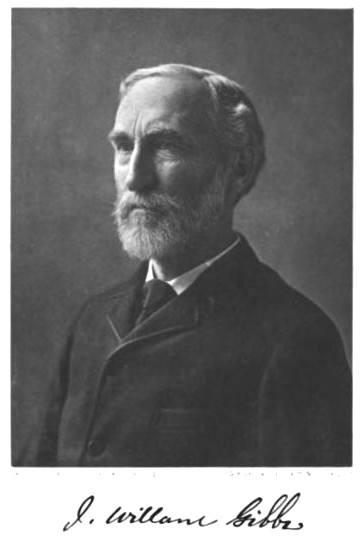
Gibbs Free Energy
 المؤلف:
University of Missouri System
المؤلف:
University of Missouri System
 المصدر:
Introductory chemistry
المصدر:
Introductory chemistry
 الجزء والصفحة:
.................
الجزء والصفحة:
.................
 22-12-2020
22-12-2020
 2449
2449
Gibbs Free Energy

A portrait of J. Willard Gibbs
J. Willard Gibbs (1839-1903) proposed a single state function to determine spontaneity:
G = H – TS
where H is the enthalpy of the system, S is the entropy of the system, and G is Gibbs free energy.
The change in Gibbs free energy, ΔG, is the maximum amount of free energy available to do useful work. For an isothermal process, it can be expressed as:
ΔG = ΔH – TΔS or at standard conditions: ΔG⁰ = ΔH⁰ – TΔS⁰
This single term, Gibbs free energy (G), allows us to avoid calculating the entropy of the surroundings. It is really just a simplification of our previous method of estimating spontaneity:
ΔSuniverse = ΔSsys + ΔSsurr
ΔSuniverse = ΔSsys + (− ΔHsys/T)
Multiply both sides of the equation by –T:
–TΔSuniverse = ΔHsys – TΔSsys
Therefore ΔG = –TΔSuniverse
As a result of this relationship, the sign of Gibbs free energy provides information on the spontaneity of a given reaction:
If ΔG > 0, the reaction is nonspontaneous in the direction written.
If ΔG = 0, the reaction is in a state of equilibrium.
If ΔG < 0, the reaction is spontaneous in the direction written.
The significance of the sign of a change in Gibbs free energy parallels the relationship of terms from the equilibrium chapter: the reaction quotient, Q, and the equilibrium constant, K.
If Q > K, the reaction is nonspontaneous in the direction written.
If Q = K, the reaction is in a state of equilibrium.
If Q < K, the reaction is spontaneous in the direction written.
Example 4
Calculate ΔG⁰ for a reaction where ΔH⁰ is equal to 36.2 kJ and ΔS⁰ is equal to 123 J/K at 298 K. Is this a spontaneous reaction?
Solution
ΔG⁰ = ΔH⁰ – TΔS⁰
ΔG⁰ = 36.2 kJ – (298 K x 123 J/K)
ΔG⁰ = -0.4 kJ
Therefore the reaction is spontaneous because ΔG⁰ is negative.
 الاكثر قراءة في الكيمياء الحرارية
الاكثر قراءة في الكيمياء الحرارية
 اخر الاخبار
اخر الاخبار
اخبار العتبة العباسية المقدسة


